Mae's Real Stories
Memories for Miriam, Alice, Theo, Delia, Tessa and anyone else who would like to be hereThursday, August 31, 2006
My friends go downtown
First we went to Selo-Sheval Gallery.

Then we went to Peaceable Kingdom. The fairies have their own store, with little windows that my friends looked into.

After they looked in the window, they went to the door that's outside.

We walked past The Ark, but the fairy door in the big door there is too high for my friends, as you can see in the picture. I guess the fairies must fly into the door when they go in.
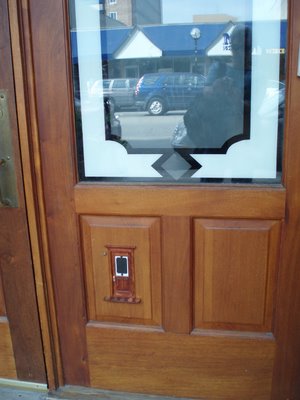
Finally, we went to Sweetwater's Cafe, where the Fairy Door is in an indoor brick wall next to a cafe table.

One thing I don't know is why a lot of people put pennies next to the fairy doors. I thought fairies didn't need any money. But these are city fairies, not the fairies that live out in the country. You can learn more about fairies in Ann Arbor at Fairy Doors.
Do you like butter?
 When I was a little girl one of my favorite stories was about Tootle Toot, the little train who wanted to be a big engine. Did you ever read this story?
When I was a little girl one of my favorite stories was about Tootle Toot, the little train who wanted to be a big engine. Did you ever read this story?I liked the part where Tootle saw the fields full of flowers and left the rails. He wanted to see the flowers. He saw some buttercups and put them under his chin. He asked "do you like butter?" He looked to see if his chin was yellow like the buttercup.
We didn't have any buttercups in our yard, but we tried the same thing with dandylions. A little bit of yellow pollen stayed on our chins. Yes, we liked butter!
Tuesday, August 29, 2006
Mark Twain in Hannibal Mo.
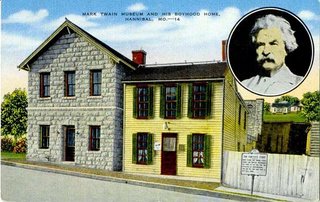 One of the places we liked to go in the car was to Hannibal. We visited the house where Mark Twain had lived.
One of the places we liked to go in the car was to Hannibal. We visited the house where Mark Twain had lived.We learned the story of Tom Sawyer and the fence. Tom's Aunt Polly told him to paint the fence. This would be a lot of work. He told all his friends that it was really fun and wonderful to paint the fence. They begged him to let them try it. He made them give him money to let them paint the fence. That way, he didn't have to do the work himself. And he got money from his friends. Mark Twain's house had a white fence. People said this was the fence he was thinking about when he wrote the story of Tom Sawyer.
 Mark Twain worked in boats on the river. We loved to look at the river and the boats that still worked on the river. In Mark Twain's book, Huck Finn took a long ride on a raft all the way down the river to New Orleans.
Mark Twain worked in boats on the river. We loved to look at the river and the boats that still worked on the river. In Mark Twain's book, Huck Finn took a long ride on a raft all the way down the river to New Orleans.Mark Twain also wrote a book about the old boats on the Mississippi River. They had big paddle wheels that moved them through the water, and big steam engines to drive the paddle wheels. A few boats like that were still on the river when we were taking our trips.
Music for the Record Player
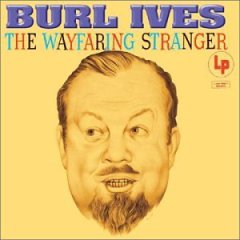 Music came on large black disks called records when we were children. We had a record player that was a box with a large turntable on top, and we loved to play music. Our parents had grown-up records like Beethoven's Pastoral Symphony. Sometimes we listened to these records, but we also had many records that were just for children, just like Miriam and Alice and Theo have now.
Music came on large black disks called records when we were children. We had a record player that was a box with a large turntable on top, and we loved to play music. Our parents had grown-up records like Beethoven's Pastoral Symphony. Sometimes we listened to these records, but we also had many records that were just for children, just like Miriam and Alice and Theo have now.One favorite was a folk singer named Burl Ives. He sang songs like "The Little White Duck" and "Oh do you remember sweet Betsy from Pike?" and "Froggie went a-courtin." In fact, you can tell that Raffi sings many of the same songs as Burl Ives.
 We had other favorites too. Arny loved a singing version of "The Nutcracker Suite." We had a record of the story "In which a house is built at Pooh Corner," and a record of the poem about the Pied Piper of Hamlin. All of us -- parents and children -- liked the song "Old Man River" sung by Paul Robeson.
We had other favorites too. Arny loved a singing version of "The Nutcracker Suite." We had a record of the story "In which a house is built at Pooh Corner," and a record of the poem about the Pied Piper of Hamlin. All of us -- parents and children -- liked the song "Old Man River" sung by Paul Robeson.One thing that was very different about records instead of CDS: they were very short. After one or two songs, the record was over, and you had to change it or play it again. The other different thing was that the big, black records were very breakable. If you dropped one, it broke into several sharp pieces.
Monday, August 28, 2006
The Peach Tree
 Almost all the way to the back of our back yard stood a peach tree. It was taller than the backyard neighbor's garage next to it. In the spring, beautiful bright pink blossoms covered the whole tree. There were enough that we could pick a few of them to put in a vase, though they didn't last very long. In the fall we sometimes had one or two greenish, hard, slightly insect-bitten peaches. (In other words, the peach tree hardly ever produced fruit -- we loved peaches but loved the tree for other reasons.)
Almost all the way to the back of our back yard stood a peach tree. It was taller than the backyard neighbor's garage next to it. In the spring, beautiful bright pink blossoms covered the whole tree. There were enough that we could pick a few of them to put in a vase, though they didn't last very long. In the fall we sometimes had one or two greenish, hard, slightly insect-bitten peaches. (In other words, the peach tree hardly ever produced fruit -- we loved peaches but loved the tree for other reasons.)The best thing about the peach tree was the lowest branch. This branch was pretty thick, and it stuck out almost level to the ground. It was near to my eye level when I was a little girl. I could grab the branch, throw a leg up around it, and pull myself into the tree. Once I was sitting on the first branch, there was a fork a little higher. It was a little scary, but I could stand up and then get up onto the fork. Sometimes I climbed higher than that. I could see the whole back yard and the roof of the nearby garages. My sister could climb anything, and she could go higher. But I really liked to get up into that tree.
Saturday, August 26, 2006
Kindergartens in St.Louis
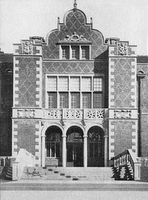 This is a picture of Clark School in St.Louis. My mother started kindergarten there about 90 years ago. For her, kindergarten was more different than for Evelyn, for me, or than it will be for Miriam, because her family did not speak English at home. She had to learn English when she went to kindergarten. Clark school was almost new when my mother went there. Now it is almost 100 years old.
This is a picture of Clark School in St.Louis. My mother started kindergarten there about 90 years ago. For her, kindergarten was more different than for Evelyn, for me, or than it will be for Miriam, because her family did not speak English at home. She had to learn English when she went to kindergarten. Clark school was almost new when my mother went there. Now it is almost 100 years old.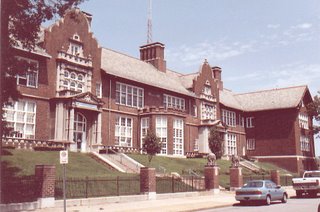
This is the front of Hamilton School where I went. I think the bay windows in front are the kindergarten's windows that I remember. The playgrounds were in back.
The next photo is Delmar-Harvard School where Elaine and Arny went to kindergarten, and where I went to school after second grade.

Thursday, August 24, 2006
Going to Kindergarten
 Miriam started to kindergarten this September (update to this post). She rode to school on the La Petite Academy bus, and then joined her teacher and the other kids. She wore her new striped dress and had her hair in braids. Her friend Abby also wore a special dress.
Miriam started to kindergarten this September (update to this post). She rode to school on the La Petite Academy bus, and then joined her teacher and the other kids. She wore her new striped dress and had her hair in braids. Her friend Abby also wore a special dress.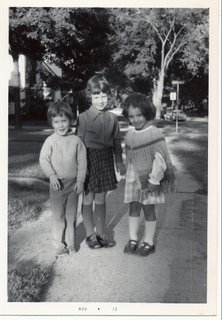 Evelyn started kindergarten a long time ago. She walked to school with Carrie Doyle. You can see Evelyn, Carrie, and Carrie's little sister Kelly in the photo. Evelyn is wearing a crocheted cape made by her Grandma Cookie and a blue and white checkered dress for her first day of school.
Evelyn started kindergarten a long time ago. She walked to school with Carrie Doyle. You can see Evelyn, Carrie, and Carrie's little sister Kelly in the photo. Evelyn is wearing a crocheted cape made by her Grandma Cookie and a blue and white checkered dress for her first day of school.It is very exciting to go to kindergarten and to be in a school for older children in first, second, and other grades. Teachers in elementary school are very different from teachers in a daycare center like La Petite Academy where Miriam and Alice go. Evelyn's kindergarten teacher, Mrs. Arnold, was very different from the teachers at Community Daycare where she went.
I started kindergarten much much longer ago than Evelyn did. My kindergarten teacher, Miss Tubasing, was very very different from my mommy. (I never went to any daycare. Also, I don't know how to spell Mrs. Tubasing's name, since I could not write when I was in kindergarten.)
My kindergarten was in the Hamilton School in St.Louis where the pupils went until they finished the eighth grade. I was one of a very large number of kindergarten children in a large room with tall windows, which opened with a long stick with a hook on the end. There were glass-paneled doors at each end of the room, with two or three steps up to each door. Near one door stood a piano with a piano bench. At the other end of the room was a playhouse. Only a few children at a time were allowed to play in the playhouse.
Near the windows were two or three rows of tables with little chairs evenly spaced around them. Six or eight kindergarteners sat together at each table most of the time. We drew pictures. We didn't yet learn to read or write. Reading and writing was for first graders.
When it was time for the class to learn or talk or sing together, we carried our little chairs from our tables. We learned to carry our little chairs carefully. We put one hand under each side of the seat. We did not put the chairs on top of our heads. That was the wrong way to carry the chair.
With our chairs, we all made a circle around the teacher. We had to be very very quiet. We had to sit very very still, and raise our hands if we wanted to say something. We all sang at the same time, while the teacher went over to the piano and played for us.
We went outside for recess. We played on a playground made of blacktop with white circles painted on it. Sometimes we just ran around the playground. Other times, we all played circle games together, like The Farmer in the Dell. It started with the farmer in the center of the painted circle with all the other children circling around and singing. The farmer picked a wife. More and more children would be picked: the wife picked the child, then the dog, the cat, the cow, the horse, and finally the cheese.
At last we sang "The Cheese stands alone." Everyone but the cheese would go back into the outer circle. Then the cheese got to be the Farmer and start the game over again. Another circle game where one child chose another to go into the center was called "Raw Candy Every Day." Maybe I don't remember the name correctly, though.
One day when I came to school, Mrs. Tubasing was not there. Instead, we had a substitute teacher. I didn't hear her name when she told us who she was. She had a white dress with blue fruit-like things on it. When I told my mother we had a substitute teacher, she asked what her name was. I said, "Mrs. Blueberry."
Abraham Lincoln

Abraham Lincoln was a great President of the United States. I learned about him when I visited Springfield and New Salem, Illinois.
Going on a Trip
 When I was a small child, we didn't travel very much because we had no car. The first trip we ever took was to Springfield and New Salem, Illinois. I was very excited to be going somewhere besides to the park and to my two aunts' houses. We rarely went anywhere in a car, but usually went on the bus or on the streetcar.
When I was a small child, we didn't travel very much because we had no car. The first trip we ever took was to Springfield and New Salem, Illinois. I was very excited to be going somewhere besides to the park and to my two aunts' houses. We rarely went anywhere in a car, but usually went on the bus or on the streetcar.We drove from St.Louis to Springfield and New Salem in a car that belonged to my father's friend Mr. Mitchell. My mother, Elaine, and I sat in the back seat. We had to be very quiet and very good, as Mr.Mitchell, who was driving, was not used to small children. He was the physics teacher at Beaumont High School where my father taught mathematics. (Later, he lived with us for about a year.)
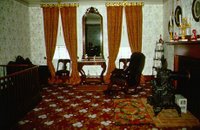 In Springfield, we visited the house where Abraham Lincoln had once lived, and also buildings that showed us what his life had been like before he became President. I understood that he was a great man, that his life was very different and long ago, and that he had been very good to free the slaves in the Civil War. I liked looking at the rooms of the house, like the one in the picture (from the Lincoln Home Tour of the National Historical Site).
In Springfield, we visited the house where Abraham Lincoln had once lived, and also buildings that showed us what his life had been like before he became President. I understood that he was a great man, that his life was very different and long ago, and that he had been very good to free the slaves in the Civil War. I liked looking at the rooms of the house, like the one in the picture (from the Lincoln Home Tour of the National Historical Site).New Salem was a village of log houses from Lincoln's time. I was very interested in these houses, as they were much more different from our apartment or my friends' houses. We learned how Lincoln had been very poor, and how he had learned to be a lawyer and later, how people had liked him so much that he could win elections and eventually become President.
 I remember that there was a special kind of fence around all the log houses, made of split logs. After I saw New Salem, I understood better about log cabins in the woods and on the prairies in the stories that teachers read to me. (This picture is from the website for New Salem.)
I remember that there was a special kind of fence around all the log houses, made of split logs. After I saw New Salem, I understood better about log cabins in the woods and on the prairies in the stories that teachers read to me. (This picture is from the website for New Salem.)Tuesday, August 22, 2006
More Games We Played
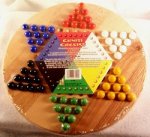
Our family owned several board games. Everyone we knew had Chinese Checkers and regular Checkers. Checkers was for only two people. Good players would win most of the time, because they knew how to plan their game. Chinese Checkers was more fun.
If you had a lot of kids together, you could play a 6-way game of Chinese Checkers, which was really fun and different from a game with only two or three players. We always seemed to lose some of the marbles that this game used.
We also went to friends' houses to play games. I had a good friend named Dorothy. She liked a game called Hex. This game had a game board and a number of blue and yellow wooden tiles with six sides each -- hexagons.
Hex was a game for just two people: one person used yellow, one blue. The board was divided up into hexagons the same size as the tiles. The players took turns placing one tile at a time on the board. You could put the first tile anywhere, but then I think you had to put the others next to one that you had already put down. You played until one person's tiles made a row that went from one side to the other. Dorothy knew how to win most of the time. I think she practiced when no one was there, or maybe one of her older brothers played with her so that she got very good at Hex.
 Arny liked Monopoly. We didn't have a Monopoly game, so he played with Lisa and Ricky across the street. A lot of kids would all go to Lisa and Ricky's house to play a game that lasted for days sometimes. In Monopoly everyone starts with a lot of play money. They take turns and move little tokens around the board.
Arny liked Monopoly. We didn't have a Monopoly game, so he played with Lisa and Ricky across the street. A lot of kids would all go to Lisa and Ricky's house to play a game that lasted for days sometimes. In Monopoly everyone starts with a lot of play money. They take turns and move little tokens around the board.If you were unlucky you got a card that said "Go directly to jail. Do not pass GO. Do not collect $200." If you went to jail you might not have a chance to win. But if you were lucky you got to buy lots of property and build hotels and houses on the property. Eventually, the winner gets all the money.
Elaine wrote: "I did NOT like Monopoly. I did like Scrabble and Clue. Monopoly was boring, especially the way Arny et al played it--forever. Joel learned to beat me in Monopoly by the time he was 5." So I was wrong when I first wrote that she liked it too.
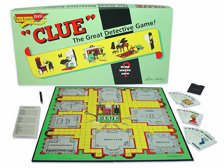 At our house, we had two mystery-solving games called Who and Clue. When you played Clue you got to ask a lot of questions about who had done a crime. Each person had a game name like Colonel Mustard.
At our house, we had two mystery-solving games called Who and Clue. When you played Clue you got to ask a lot of questions about who had done a crime. Each person had a game name like Colonel Mustard.Sunday, August 20, 2006
The Game of Authors and other card games
 Louisa May Alcott was one of the authors in the card game called Authors. For each author the card game had four cards with the author's picture on each one. The cards also named four books by the author. The name of one book was at the top to make the cards all different from each other.
Louisa May Alcott was one of the authors in the card game called Authors. For each author the card game had four cards with the author's picture on each one. The cards also named four books by the author. The name of one book was at the top to make the cards all different from each other.When you played Authors, first one person, the "dealer," would give each player some cards. When you took your turn, you could ask for cards by saying the name of an author or the name of a book. If another player had a card with that author or book at the top, she would have to give it to you. When you got all four cards for one author, you would put them down on the table. At the end, the person with the most cards on the table was the winner. In all there were thirteen authors with four books each.
Mark Twain, Charles Dickens, and Robert Lewis Stevenson were some of the authors. You can see their pictures on the cards here.
I liked Louisa May Alcott because I had read some books by her, like Little Women. I had not read books by most of the other authors then, but by now I have read something by all the authors.
I especially liked to say the names of these authors: Henry Wordsworth Longfellow. Alfred, Lord Tennyson. James Fenimore Cooper. William Makepeace Thackeray. All of the authors lived a long time ago, so I thought that some of them were sort of funny looking.
We played other card games too, like Old Maid, Go Fish, and War. When we got older, we also learned to play Casino. My father taught us this game. I learned to play Canasta and Gin Rummy from my cousin Marcia. My aunts liked to play cards with their friends, but my mother and father never played cards with other grownups, and I don't think my mother liked to play cards at all.
We also played a lot of board games. My favorites were Who, Clue, and Scrabble. Elaine and Arny liked Monopoly.
Saturday, August 12, 2006
Castles in the Air and "Little Women"
 "Wouldn't it be fun if all the castles in the air which we make could come true, and we could live in them?" said Jo, after a little pause.
"Wouldn't it be fun if all the castles in the air which we make could come true, and we could live in them?" said Jo, after a little pause. "I've made such quantities it would be hard to choose which I'd have," said Laurie, lying flat and throwing cones at the squirrel who had betrayed him.
"You'd have to take your favorite one. What is it?" asked Meg.
"If I tell mine, will you tell yours?"
--- Chapter 13 of Little Women
Castles in the air are a name for the things you think about, things that you want to see or do in the future. When I was a little girl, I loved to read a book called Little Women by Louisa May Alcott. I read it many times, and I liked the idea of castles in the air from the book.
Louisa May Alcott lived long before I was born, and her stories took place more than one hundred years ago. The family in Little Women lived in a big house like the one in the picture, which is Louisa May Alcott's real home. One sister named Beth liked to play the piano. Here they are listening, while their mother, called Marmee, was sewing:
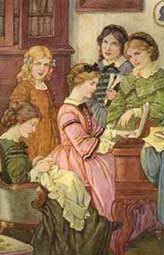
I loved the part of the book where the four sisters called the Little Women and their friend, a boy named Laurie, all told what they wanted -- told about their castles in the air. Jo was the name of my favorite sister of the four. Here is what she wanted:
"I'd have a stable full of Arabian steeds, rooms piled high with books, and I'd write out of a magic inkstand, so that my works should be as famous as Laurie's music. I want to do something splendid before I go into my castle, something heroic or wonderful that won't be forgotten after I'm dead. I don't know what, but I'm on the watch for it, and mean to astonish you all some day. I think I shall write books, and get rich and famous, that would suit me, so that is my favorite dream."
Many girls have read that book and have wanted to be like Jo, and like Louisa May Alcott who wrote the book partly about her own life.
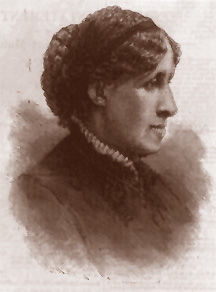
Louisa May Alcott (1832-1888)
What I really liked in Little Women was the idea that your thoughts were like castles that you built in the air, just thinking about what you wanted to do. One thing I really wanted to do was to see real castles! I wanted to travel. Later in the book, one sister named Amy did get to go to Europe and see some castles. Jo didn't get to go there. But Jo did write stories, just like Louisia May Alcott.
Friday, August 11, 2006
Hot and Cold Lava in Hawaii
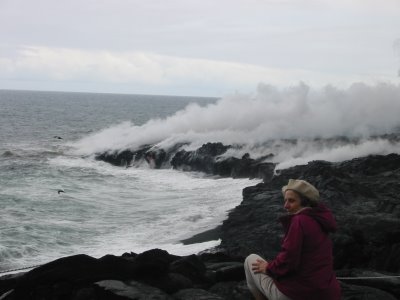
Once, as this picture shows, we saw lava dripping from a lava vent into the ocean, making a huge plume of steam. The steam is easy to see in the picture. If you click on this picture and see it enlarged, you can see a little red-hot lava running down the cliff by the ocean. Lava is melted rock. It is the hottest thing on earth, I think.
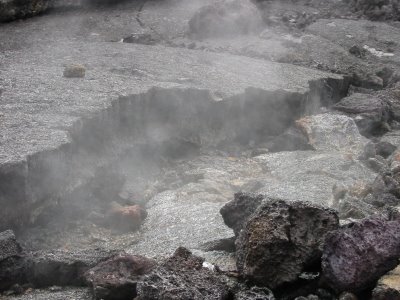
As you walk through the old lava fields, you smell funny smelling fumes coming up from cracks in the rock, because the volcanic action under the rocks produces all sorts of poison gas. It is very desolate but beautiful to walk through these large black rock fields. The gases leave colored marks on the black lava rock.

Farther from the most active volcano is old, cold lava. The lava went out of this volcano through tubes (or vents) underground. When the lava all flowed away, the lava tube was like a big cave. Now people walk through it every day.
Everywhere in Hawaii you can see different kinds of lava, because every one of the Hawaiian islands blew up from the Pacific Ocean in a volcanic blast. Some were as long as a million years ago. The volcano now sending lava into the sea is slowly creating new land at the edge of the biggest Hawaiian island.
Wednesday, August 09, 2006
The Girl Graduate's Record Book
 My mother graduated from high school in 1927. During high school and junior high, she kept an album of photos, clippings, party invitations, autographs, and drawings that her friends made. The album is very fragile, but I have copied a few pages.
My mother graduated from high school in 1927. During high school and junior high, she kept an album of photos, clippings, party invitations, autographs, and drawings that her friends made. The album is very fragile, but I have copied a few pages.The real story in these pages is the story that my mother told about her life up to that point, her high-school graduation. I'm glad she saved this album so that her great grandchildren could see what she had written.


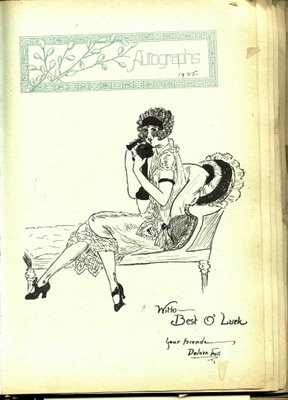
On the last page one of the friends drew a very fashionable girl talking on a telephone. This shows you what was in style and what telephones looked like a long time ago. The other friends also made pictures of things they liked.
Tuesday, August 08, 2006
Family Cars
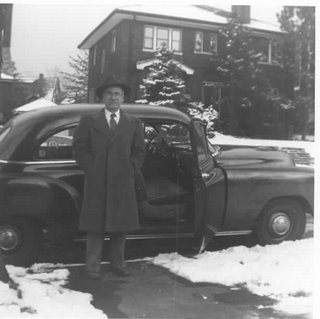 This is my father in front of his Chevrolet. He bought it in around 1950. At that time, Arny was just learning to talk, and he always said "green car." But the car we got was black. It was the simplest and one of the least expensive cars. We thought it was a wonderful car. We took trips and rides in the country, and my father did the grocery shopping. My mother didn't have to carry bags of groceries while pushing a baby carriage or stroller, or rely on her sisters to sometimes do some of the shopping for her.
This is my father in front of his Chevrolet. He bought it in around 1950. At that time, Arny was just learning to talk, and he always said "green car." But the car we got was black. It was the simplest and one of the least expensive cars. We thought it was a wonderful car. We took trips and rides in the country, and my father did the grocery shopping. My mother didn't have to carry bags of groceries while pushing a baby carriage or stroller, or rely on her sisters to sometimes do some of the shopping for her.In the 1950s, a lot of people bought a new car every year, or at least every 2 or 3 years. The car companies would change the look of cars so that everyone would want to get a new car all the time. My father thought that was really stupid. He kept our Chevrolet for around ten years.
 Everyone thought that was amazing, if not a little strange. Finally, he had to buy another car. He chose a Rambler, which was considered to be a very practical car. Soon after that, we took another very long trip.
Everyone thought that was amazing, if not a little strange. Finally, he had to buy another car. He chose a Rambler, which was considered to be a very practical car. Soon after that, we took another very long trip.In the picture, you can see that he's unloading the groceries. My mother never did learn to drive a car at all, so he always went to the grocery store with a list of the things she needed in order to make our breakfast, pack our school lunches, make dinner, and make the pies that Elaine talked about.
My father kept the Rambler for almost ten years too. By the end of that time, a lot of people began to agree with him, and thought it was stupid to buy a car every year.
The Baba Doll
 Here are three nesting dolls that we used to play with when we were children. We liked to take the large doll and the middle-sided doll apart and put them back together. The littlest doll didn't come apart. The dolls are made of wood, so we were allowed to play with them without being afraid they would break. Eventually, the flowers and faces painted on the wood began to chip and look old.
Here are three nesting dolls that we used to play with when we were children. We liked to take the large doll and the middle-sided doll apart and put them back together. The littlest doll didn't come apart. The dolls are made of wood, so we were allowed to play with them without being afraid they would break. Eventually, the flowers and faces painted on the wood began to chip and look old.My mother called the biggest doll the "Baba Doll" because it was wearing a scarf like her grandmother's scarf. (You can see the scarf in the picture of her grandmother).
Our mother used to tell us how she bought this set of dolls on her honeymoon, right after she and my father were married. She would describe how they drove from St.Louis all the way to Bemidji, Minnesota in his car. We looked at the pictures that she had drawn and post cards of the trip. She had a post card of a statue of Paul Bunyan, the legendary lumberjack, and his great blue ox Babe. Paul Bunyan had a red and black checked lumberjack shirt. I also remember a post card of a big iron mine where men worked on little trains carrying iron ore.
Here is a recent picture of Paul Bunyan in Bemidji. I think it must be the same one my parents saw 65 years ago.

Monday, August 07, 2006
The Nickel Dolls
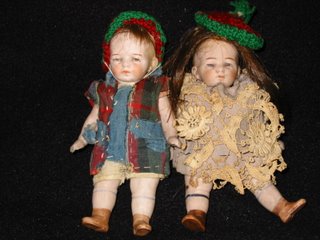 These are my mother's dolls. They were called "Nickel Dolls" because that was how much they cost. They are very small. For a penny, she could also buy an even smaller doll.
These are my mother's dolls. They were called "Nickel Dolls" because that was how much they cost. They are very small. For a penny, she could also buy an even smaller doll.My mother and her sisters made their clothes from scraps of cloth. The lace scrap was from my grandmother's wedding dress. I think they crocheted the hats. They even made the hairpieces out of little bits of my aunts' hair. My mother had long curls, so she didn't want to cut any little pieces off of her own hair.
My mother liked to play with these dolls when she was a little girl, about 85 or 90 years ago. She saved them, but when we were little children, she only showed them to us. She knew that they were too fragile for us to play with them. I'm glad she saved them, because I still have them now.
The Artist's Grandmother
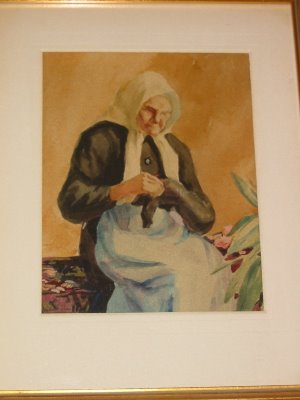
This is my mother's grandmother. So -- to Miriam, Alice, and Theo, she is a great-great-great-grandmother. My mother painted this picture a long time ago. In the picture, the grandmother is mending a stocking. Her had is inside the stocking. In her hand inside the stocking is a round wooden tool called a darning egg. This darning egg allowed you to sew up a hole in a stocking without sticking the needle into your fingers.
Many family members lived together at the time of this painting. My mother, her younger brother, her mother, and her grandmother all lived in a rather small house. When she painted the picture, her older two sisters and two brothers were married with children. But they sometimes lived with their mother too. So my mother got to know her nieces and nephews very well. Her niece Merilyn still keeps this picture on the wall of her house in St.Louis.
The woman in the portrait is Mottle N'movitch Stepansky Binder (1847-1932). Her grandchildren called her "Baba" which means Grandmother. She married Beryl Stepansky (1835-1879) in 1869. They had several children, including my grandmother. Later, he died. When my grandparents, Morris Binder and Dora Stepansky, were getting married, she met my grandfather's father, and married him. He also died.
Mottle came to the United States in 1906 with Morris and Dora and their three older children: Ben, Jack, and Bernadine. The younger children, Sadie, Evelyn (my mother, and your great-grandmother), and Erwin, were born in St.Louis. So our ancestors have been in the US for exactly 100 years.
The Artist
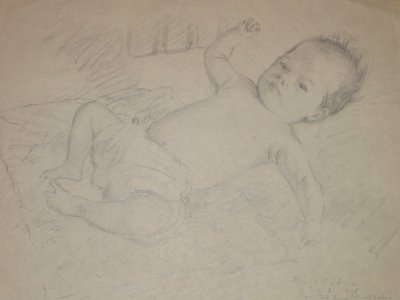
Our mother loved to draw. She had majored in art during the three years she attended university, years before she married and had children. She always drew our pictures. Since I'm writing this in response to Elaine's stories for Theo, I have chosen the picture above, which shows Elaine as a baby.
My mother always had lots of art materials and projects for us to do, so I also loved to draw when I was a child. She also had a lot of special skills and imagination, which we attributed to her artistic skill. For example, Elaine remembered the wonderful pies she made. I also remember that she could divide a pie into any number of pieces she needed: 5, 10, 7. And they seemed to come out equal sizes. She called this her artistic eye. Our father always expressed his admiration for this ability.
Our mother loved to imagine the colors that were concealed in black and white photos. Later she applied her skill to television pictures. She would tell us what color things would have been, if the TV images had been in color. You see, for the first 10 years or more of TV broadcasting, only shades of grey appeared on TV -- that's what is meant by "black and white" TV. After a while, a few people bought color TVs, and more and more broadcasts were in color. Today, the only black and white broadcasts are of old films or TV shows that were never in color.
Here is an example of a black and white TV image that she would have "colored" -- it shows Sid Caesar and Imogene Coca, the stars of one of our family favorite shows. (from http://www.fiftiesweb.com/)

The House In University City

These two 1950 photos came from the realtor who sold us the house. You can see the "For Sale" signs out front. The oak tree which is now in the front yard wasn't there yet -- my father planted it some time later from a "volunteer" that grew up in the iris beds which, at that time divided our property from the half-lot just to the south. A small number of irises are still located there, probably the descendants of the originals. The photos also show the bushes and evergreen trees that stood at the corner of the lot and in front of the house, now mainly gone. Unfortunately, some of the stone urns in front of the house were stolen relatively recently. The remaining ones still show the traces of silver paint that Uncle Sam applied to them once while we were on vacation, to my mother's chagrin.

Arny in the Back Yard, 1951
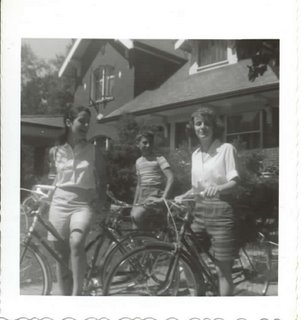
Three of us on bikes, 1962

Elaine in the yard, 1962
The 1951 and 62 photos that show the back of the house/yard indicate how the landscaping appeared at that time. A large maple tree was offset from the path, which was lined with irises all the way to the garage and in front of it, and you can see the flowering Spirea bush in one image. (I can't remember if there are bushes alongside the back of the house now.) The 1951 backyard photo shows Arny with his toy lawnmower, and the 1962 photo shows Elaine sitting on the grass. There were always lots of clover and plantain weeds among the grass, and still are, though the new owner, who just moved in three months ago, seemed ambitious about the lawn.
Elaine thinks that a small decorative pond once occupied part of the back yard on the driveway side before we lived there. A hedge row separated the driveway from the yard, and on the opposite side was an open, trellis-style fence with the remnants of someone's garden: a peony, a rosebush, a climbing rose, a few other flowers. We weren't great gardeners, and didn't change anything much. The fence is now gone, and the area belonging to the next-door house is all open lawn, while the back part was formerly a sort of wild and unweeded thicket of trees and shrubbery.
I don't think I have any photos that show any details of the interior of the house in any interesting way. Back then, film was slow, flash equipment was specialized, and we weren't great photographers -- we just used outdoor light. The 1955 and 1962 photos of the front of the house also look very much like the house does today. The 1955 picture shows that we had an aluminum storm/screen door on the front double doors, but that's of little historic interest. It amused me to see that the cracked and crazed varnish on the dark wood of the front doors appears the same as it did 40 years ago, but the new owner says he plans to refinish the wood. The beautiful beveled glass remains.
Inside, on our visit in 2002, we found that little has changed in the beautiful details of the house -- deep, elaborate mouldings and woodwork; marble-topped radiators, art deco-style light fixtures, built-in cupboards in the butler's pantry and small front bedroom, glass bathroom tile (just restored), sunroom doors, windows, even window handles. Central air conditioning now occupies the crawl space above the second floor, which was accessible only through a trap door, and which I never saw. It's delivered through ceiling ducts, that make no visible difference, but which makes a welcome change in the unbearable heat and humidity of St.Louis summer.
A major change is the new kitchen with cherry cabinets and granite counter tops, with the pantry removed and used as the location for a huge refrigerator, and a large central island where our kitchen table stood. In the fifties, we had few cabinets in the kitchen, relying on the pantry and china cabinet in the dining room. Our refrigerator, an old Admiral with heavy latched doors and rounded corners, was all alone on the wall near the pantry door. We loved it because it could keep ice cream cold enough that we could eat it whenever we wanted to. I suspect the white-painted wood cabinets and linoleum floor that were there when we moved in dated from the 1930s. My parents replaced most of these with metal cabinets from Sears, and replaced a small stove with a large white range including a built-in rotisserie oven and impressive, lighted control panel. Eventually they also replaced the worn linoleum, which was a green, white, and brown pattern of squares and rectangles.
I hope Elaine will continue with lots of good stories about this time in our lives.
Elaine's Real Stories
Here are two photos that illustrate her real stories. The first is Elaine in her Taylor-Tot. The second is our parents and the two of us.
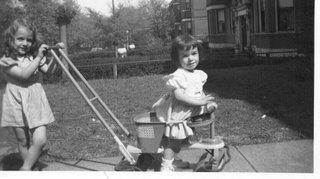
Label on back: "Mae & Elaine, June 1947"
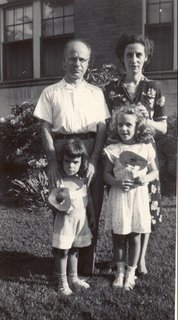
Label on back: "The four Feldmans Aug 18, 1948"
Archives
August 2006 September 2006 October 2006 November 2006 December 2006 January 2007 February 2007 March 2007 April 2007 May 2007 June 2007 July 2007 August 2007 September 2007 October 2007 November 2007 December 2007 January 2008 February 2008 March 2008 April 2008 May 2008 June 2008 July 2008 August 2008 September 2008 October 2008 November 2008 December 2008 January 2009 February 2009 March 2009 April 2009 May 2009 June 2009 July 2009 August 2009 September 2009 October 2009 November 2009 December 2009 January 2010 February 2010 March 2010 April 2010 May 2010 June 2010 September 2010 October 2010 November 2010 February 2011 May 2011 September 2011 March 2012 April 2012 May 2012
Subscribe to Posts [Atom]